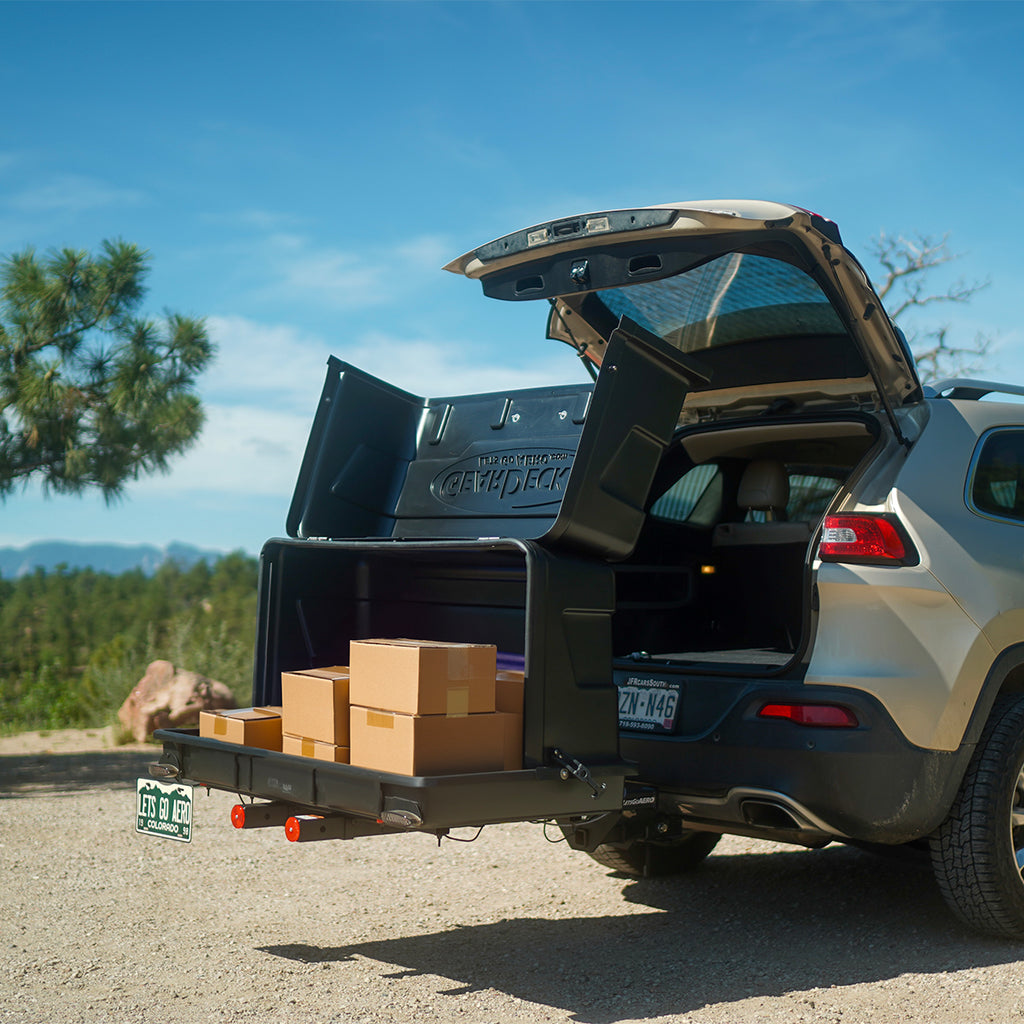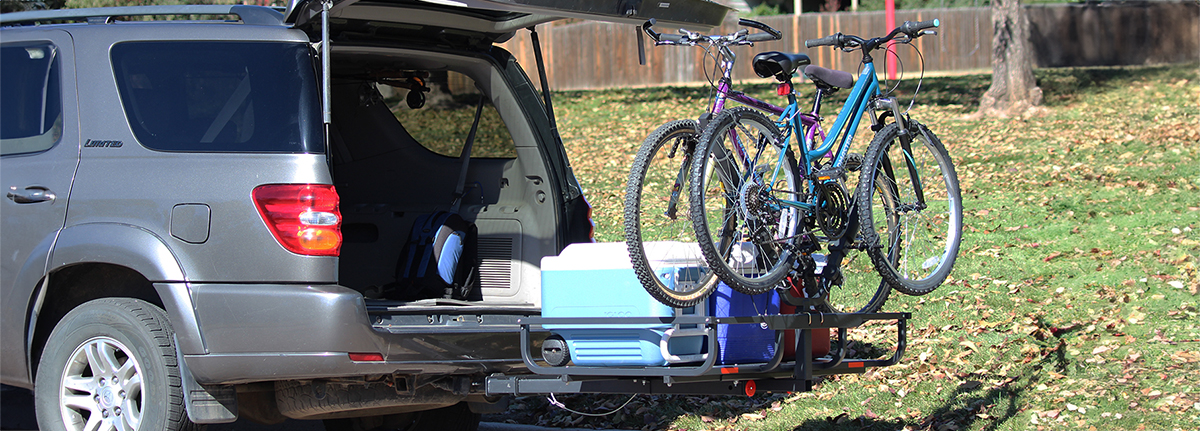Road trips and vacations offer the perfect escape, but ensuring that your gear arrives safely is important to fully enjoy a stress-free journey. A hitch cargo carrier is an excellent solution for expanding your vehicle's storage capacity, allowing you to bring along all the essentials without overcrowding your car. However, packing efficiently is crucial to maximizing space and ensuring safety on the road.
This guide will walk you through everything you need to know to expertly pack a hitch carrier, from choosing the right one to unpacking at your destination.

Choosing the Right Hitch Cargo Carrier
Selecting the appropriate hitch cargo carrier is the first step to a successful road trip journey. Different types of carriers suit different needs, so it's important to choose one that aligns with your travel plans.
Types of Hitch Cargo Carriers
-
Hitch Racks & Basket-Style Carriers: These open-frame carriers are versatile and ideal for carrying items of many shapes and sizes. They are typically made from steel with either solid or grated floors and metal railings to hold in gear. They’re open design is easy to load and naturally provides multiple for tie-downs, making them perfect for hauling gear like coolers and camping equipment.

GearCage T6 Hitch Rack
The GearCage T6 Tilt-Up Cargo Rack is a versatile, open-frame carrier offering 300 lbs of capacity for hauling bulky items like coolers and camping gear. Its innovative tilt-up design provides easy access to the rear of your vehicle, making it perfect for adventure seekers who need extra storage without sacrificing convenience.
-
Enclosed Carriers: For those concerned about weather protection or security, enclosed carriers offer a solution that keeps your belongings shielded from the elements. Usually made with a combination of a plastic box and a steal frame, enclosed carriers provide a locked away space for sensitive and expensive gear, safe from wet weather and road grime.

GearDeck Enclosed Cargo Carriers
The GearDeck Slide-Out Cargo Carrier with LED offers a weather-resistant, enclosed storage solution with 17 cubic feet of space, perfect for keeping your gear secure and protected. Its convenient slide-out design provides easy rear access, while integrated LED lighting ensures visibility in low-light conditions, making it ideal for road trips and outdoor adventures.
But wait what about rooftop cargo carriers?
Due to their significant impact on vehicle fuel milage, we don't typically recommend the use of rooftop cargo carrier unless you are unable to add a hitch your vehicle. However, if you do have a rooftop carrier, all of our recommendations for enclosed cargo carriers hold true for roof mounted racks.

Factors to Consider When Choosing a Carrier
- Size: Ensure the carrier provides enough space for your gear. Stack up your intended gear ahead of time and measure the space you will need, this will give you the best idea of the measurements you need when comparing models and brands.
- Weight Capacity: Choose a carrier that can handle the combined weight of your gear and the carrier without exceeding your vehicle’s hitch rating.
- Weather Resistance: If you’re traveling in varying weather conditions, opt for a carrier with weather-resistant features or pair it with protective covers.
- Compatibility: Verify that the carrier is compatible with your vehicle’s hitch receiver, taking into account factors like the hitch class and the carrier’s attachment method. Confirm all your measurements before purchasing to ensure you don't require extension or adapters which may effect your fit and even weight capacity. Consider if you require functionality such as a slide-out or swingaway for rear access to things like rear SUV hatches or Sprinter van barn doors. or bike attachments to mount bicycles as wells as gear.
Efficient Packing Techniques
Once you've selected the right carrier, packing it efficiently is the next challenge. But never fear, at Let's Go Aero we refer to the art as "playing tetris". Just like the classic 80's game, fitting your gear together efficiently and appropriate is going to help you make the most of the available space while ensuring your gear stays secure throughout the journey.
1. Start with the Heavy Items
Place heavier items at the bottom and towards the center of the carrier. This lowers the center of gravity, and increases your vehicle and carrier stability. Additionally, it prevents heavier items from crushing lighter, more delicate gear.

2. Distribute Weight Evenly Across the Carrier
Even weight distribution is crucial for maintaining vehicle balance. Arrange items so that weight is evenly spread from side to side and front to back. Uneven packing can lead to poor vehicle handling, especially at higher speeds or on winding roads and cause damage to less supported areas of the carrier over time.
3. Use Soft Items for Cushioning
Items like sleeping bags, blankets, or soft duffels can be used to cushion more fragile items like electric, bikes and grills. This not only protects your gear but also helps to fill in gaps, preventing items from shifting and sliding during transit.
4. Secure Your Load
Regardless of the carrier size or style, always secure your load with straps, bungee cords, or rope. Tighten everything down securely and check it periodically during your trip. A tightly secured load reduces the risk of items shifting or falling out.
4a. Employ a Cargo Net for Additional Security
For added peace of mind, use a cargo net to cover the entire load, particularly with basket-style carriers. This helps keep everything in place, even on rough terrain with light weight objects.

5. Protect Items from the Elements
Weather can be unpredictable, so it’s wise to use waterproof bags or tarps to protect your belongings when using a open hitch racks (or even sometimes with cargo cariers). This is especially important for items that are sensitive to moisture, like electronics or clothing. If using an open carrier, a weather-resistant cover or tarp is a must but it also recommended for the inside of enclosed cargo carrier if you expect to go through strong torrential rains as an extra security.
Safety Tips and Best Practices
The most important rule of the road is safety, and a well-packed cargo carrier plays a big role in this.
Regularly Check the Load During Stops
It’s important to periodically stop and check your load, especially on long trips. Vibrations from the road can cause straps to loosen, gear to shift and possible rubbing and damage to occur. A quick check can prevent potential accidents.

Be Mindful of the Carrier's Effect on Vehicle Handling and Parking
A loaded cargo carrier changes your vehicle’s dynamics. Be mindful of your vehicle's new length, particularly when changing lanes or parking. Additionally, heavy loads can affect a cars handling, especially during sharp turns or sudden stops.
Adhere to Weight Limits and Road Regulations
Never exceed the weight capacity of your hitch or cargo carrier. Overloading can lead to dangerous driving conditions, including swaying and slower braking. Be aware of any road regulations regarding load limits and securement.
Unpacking and Storage
After reaching your destination, the next step is safely unpacking your gear and storing your carrier for future use.

Tips for Safely Unpacking Your Carrier
Unloading should be done with care, especially if items have shifted during transit. Start with the lightest items and work your way down to the heaviest. This minimizes the risk of injury and prevents heavier items from toppling over.
Proper Storage of Your Hitch Cargo Carrier
When not in use, store your carrier in a dry, sheltered area. Before storing, wipe down the carrier to prevent rusting and if it’s an enclosed carrier, make sure it’s clean and dry on the inside to prevent mildew. Consider using a cover to protect it from dust and debris in the off-season.

FAQs
How do you stabilize a hitch cargo carrier?
Stabilization starts by making sure the carrier is properly attached to the hitch receiver, using an anti-rattle hitch pin or hitch stabilizer (if not already included with your carrier). Evenly distributing weight and securing the load tightly also helps minimize movement.
 |
Silent Hitch Pin The Silent Hitch Pin eliminates noise and wobble from your hitch-mounted accessories, ensuring a secure and quiet ride. Designed for easy installation, this anti-rattle pin provides stability and peace of mind, making it perfect for trailers, cargo carriers, and bike racks. |
How much weight can you put on a hitch cargo carrier?
The weight limit depends on both the carrier and the vehicle’s hitch rating. Always refer to the manufacturer’s guidelines for both the carrier and your vehicle to avoid exceeding the recommended weight. You're weight may also be affected by other factors such as, use adapters or extensions and the distance your load weight is from your vehicle hitch face. As a general rule of thumb, your weight capacity is reduced by 20% for every foot you extend from the vehicle hitch face. Download our quick PDF on weight capacity guidelines for more information on weight load limits.
How do I stop my cargo trailer from swaying?
Swaying can often be prevented by distributing weight evenly on the carrier, using anti-rattle hitch pin or hitch tightener, and driving at appropriate speeds. It’s also important to never overload your carrier both for the sake of your carrier and your vehicle.

Securing Your Success on the Road
Whether you’re heading out for a weekend getaway or a cross-country adventure, following these expert tips will help you maximize your space, protect your gear, and maintain safe driving conditions. By selecting the right cargo hitch carrier, packing it efficiently, and following to safety guidelines, you can avoid common pitfalls and enjoy the journey with peace of mind. With everything packed securely, you can focus on what really matters: the experiences that await you on the open road. Safe travels, and enjoy the ride!





